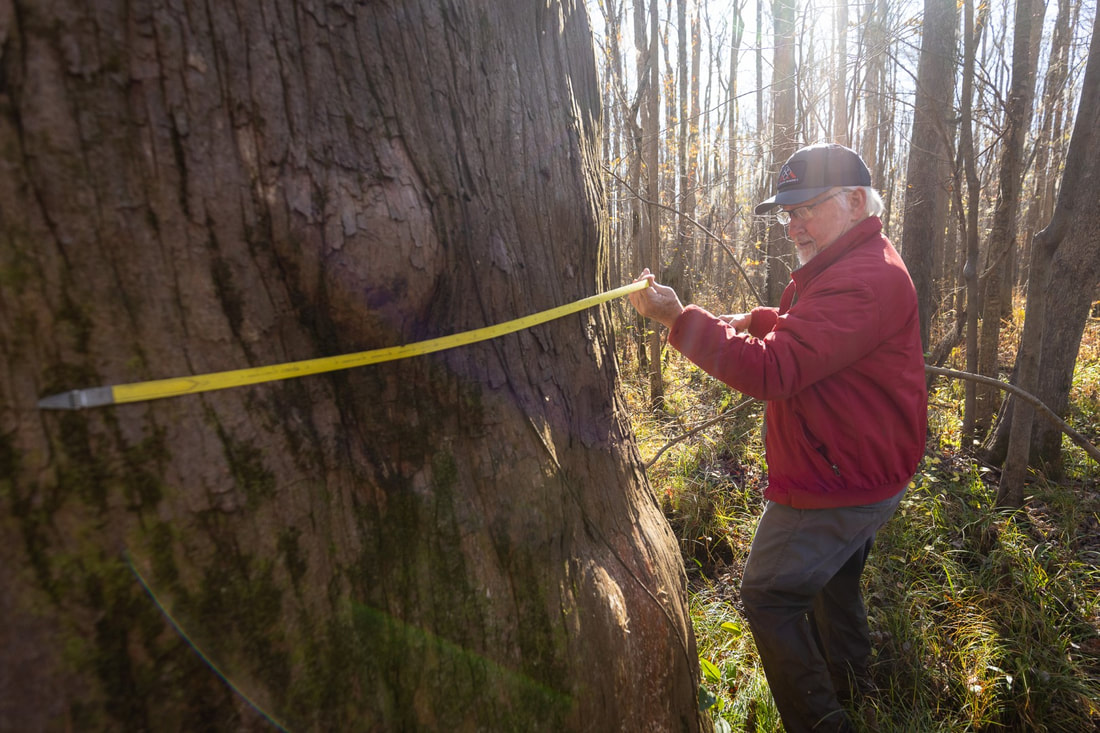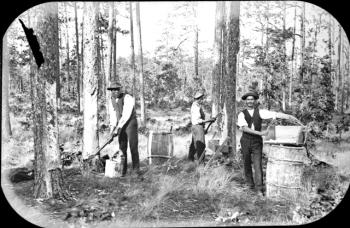Photo copyright Mac Stone
About the Black River and Our Goals
|
SIGNIFICANCE
The Black River, a major tributary to the Cape Fear River in southeastern North Carolina, is an extraordinary natural area of profound ecological significance to the nation. This is the largest expanse of old-growth swamp forest surviving in America. Ancient bald cypress trees have thrived along the riverbanks for millennia, with one remarkable specimen reaching an awe-inspiring age over 2,630 years, and some likely older, while hundreds of trees exceed 1,000 years in age. These venerable trees are among the oldest on Earth and hold the distinction of being the world's oldest known wetland trees. The Black River's clear tea-colored waters flow through areas of rich biotic diversity, and the river’s floodplain remains largely undeveloped--a place of serene beauty that is unrivalled in the South. Recognized for its outstanding water quality, the Black River faces ongoing threats from logging, development, and water flow diversions and pollution that endanger this invaluable ecosystem. Cherished by the local residents of Bladen, Pender, and Sampson Counties, the Black River and its principal tributary streams, including Moore’s and Coharie Creeks, possess natural, cultural, and historic features of national importance. The ancient forest along the lower Black River has gained widespread national and regional attention and publicity in a variety of publications, including that of the National Geographic Society. BENEFITS
Preservation of the ancient forests and pristine waters of the Black River holds immense value for the local community, the citizens of North Carolina, and the nation. Thanks to the preservation efforts of The Nature Conservancy, public access to this extraordinary ecosystem has been maintained while the old-growth forests, rare plants and animals, and clean water have been protected. PARTICIPATION You can support the goals of the Friends of Black River. Get in touch through our Contact page. |
We believe there will be a positive economic impact by promoting natural and cultural heritage tourism throughout the Lower Cape Fear Region for the Wilmington area and throughout southeastern North Carolina. Protected lands along the Black River = 10,803 acres, with another 7,584 acres protected along the river's major tributary streams. (The Nature Conservancy, NC, Dec. 14, 2023) For more than 35 years, protection of the Black River corridor has been a high priority and focus of efforts by The Nature Conservancy. |
GOALS
The mission of Friends of the Black River (North Carolina) is to ensure perpetual protection and care of this magnificent 60-mile-long stream and the diverse natural communities, plants, animals, pristine water, and historic features of this river and its tributary streams. We advocate passionately for a unified effort involving private, state, and federal landowners and stakeholders. We support continuing efforts by The Nature Conservancy to preserve land and water along the river and will assist that ongoing endeavor. Near the Black River are the hallowed grounds of Moore’s Creek National Battlefield (National Park Service)--site of the first significant victory by the Patriots of the American Revolutionary War in early 1776. Conceivably, parts of the lower Black River may eventually be recognized as a national preserve for its ecological and historical significance. Much of the land adjacent to the river and tributary streams is already protected by voluntary conservation management agreements with private property owners. We support community access and the continuation of traditional fishing, hunting, and other compatible low-impact recreational uses along the river. Preservation recognition of the Black River will ensure that time-honored pursuits continue in this special place, help maintain public access, and safeguard these ecological and historical resources so that the traditional ways and rural heritage of this deeply cherished waterway will persist. INITIAL SPONSORS Southern Conservation Partners (SCP) is willing initially to sponsor and host the proposed Friends of the Black River, and hopes to be joined by other allied organizations in support of this effort. SCP is a nonprofit charity dedicated to promoting partnerships and sponsoring innovations to conserve, restore, respect, and care for natural and cultural heritage resources in the southern U.S. See our website. |
In Salt Magazine, writer Virginia Holman reported on the surprising and hopeful story of the Black River, its trees, and the people who love it:
"On May 9, 2019, in the rural floodplain hamlet of Ivanhoe, North Carolina, 12 members of the media gathered with conservationists at the bottom of a steep, soft sand driveway thick with coppery pine straw and spent catkins. There, beside the banks of a slow-moving blackwater swamp, esteemed dendrochronologist Dr. David Stahle, conservationist Julie Moore, and Angie Carl of the Nature Conservancy stood silent as a small congregation of writers and reporters prepared our recording devices and cameras. . . ." READ Tree People: The 40-year Journey to Protect North Carolina’s Ancient Cypress Forest
"On May 9, 2019, in the rural floodplain hamlet of Ivanhoe, North Carolina, 12 members of the media gathered with conservationists at the bottom of a steep, soft sand driveway thick with coppery pine straw and spent catkins. There, beside the banks of a slow-moving blackwater swamp, esteemed dendrochronologist Dr. David Stahle, conservationist Julie Moore, and Angie Carl of the Nature Conservancy stood silent as a small congregation of writers and reporters prepared our recording devices and cameras. . . ." READ Tree People: The 40-year Journey to Protect North Carolina’s Ancient Cypress Forest
Key Ecological Attributes*
- The Black River of southeastern North Carolina is one of the great natural areas of the United States. The river’s bottomlands and swamp forests are extensive and generally of excellent quality.
- The bald cypress and bottomland hardwood forested wetlands of the Black River include the oldest living trees in eastern North America and are among the oldest living trees on earth.
- The oldest bald cypress tree so far documented is at least 2,630-years old, and among many others dating between one and three thousand years old. Only five tree species on earth are known to be capable of living for more than 2,500-years, including the ancient bald cypress of the Black River. The Black River’s bald cypress trees are the oldest wetlands tree species known on earth.
- The Black River corridor contains the largest extent of old-growth bald cypress-dominated swamp forest surviving in America, exceeding in size even those in Corkscrew Swamp Sanctuary in Florida and Francis Biedler-Four Hole Swamp In South Carolina (ref. David Stahle).
- The State of North Carolina in 1995 designated the Black River as “Outstanding Resource Waters.”
- The Nature Conservancy and other conservation partner organizations protect over 10,800 acres acres of forested wetlands, streams, and marshes in the river’s riparian corridor, and more than 7,500 acres protected on the river's major tributary streams.
- Bald cypress and bottomland hardwood wetlands have been dramatically reduced since Euro-American settlement, and the Black River and Cape Fear River systems support some of the highest quality natural communities and wildlife habitat left on the Atlantic Coastal Plain, including habitats for several threatened and rare species.
*This list is from the Potential National Natural Landmark, Proposal of the Black River in North Carolina, November 2023
Historic & Cultural Attributes
|
The Black River is within the Coharie and Waccamaw-Siouan Native American tribal territories and is within the Gullah-Geechee Cultural Heritage Corridor. Settlement along the river by European colonial emigrants began in the late 1600s–early 1700s period.
The Black River Road was established for use by the early colonial settlers in addition to their riverboat transit. That roadway ran through what is now the National Park Service’s Moores Creek National Battlefield —which is located on the tributary stream only a short distance from the main channel of the Black River. This was the site of the first military encounter on February 27, 1776, that effectively began the American Revolutionary War (several months in advance of the better known skirmishes at Lexington and Concord, MA). Here a “Royalist-Loyalist” force of about a thousand troops, principally Scottish settlers loyal to the British Crown, were annihilated by a “Rebel” force of about a thousand colonists: the loyalists’ broadswords and muskets versus the rebels’ massed muskets and small cannon fire; with the rebel Patriots capturing about 850 British loyalists along with their 1,850 muskets and shotguns, 150 swords, 13 wagons and teams of horses, and a cache of gold bullion. Here the American Revolutionary War actually began. That battle is considered to be the first significant Patriot victory of the American Revolution. A post-Civil War “Freedmen” settlement of formerly enslaved Afro-Americans was located on the river. In the 19th century there were thirty steamboat landings along the Black River for the robust commercial trade and export principally of timber and naval store products. During the late 18th, all of the 19th, and early 20th centuries the river served as a route for and means of transport for rafts or shallow-draft boats carrying longleaf pine lumber and “naval stores”—barrels of tar, pitch, and turpentine, downriver to the port of Wilmington. But the river’s characteristic shallow and meandering waters with frequent shoaling and changes in course combined to defy efforts to make it a commercial corridor or to impose “river maintenance” engineering. Boiler explosions, fires, and snags wrecked at least seven steamboats and countless rafts on the river. Point Caswell was the center of boat construction on the river, but it declined into a ghost town in the early 20th century. The Black River returned to being an unrestricted, free-flowing natural and scenic river. |





